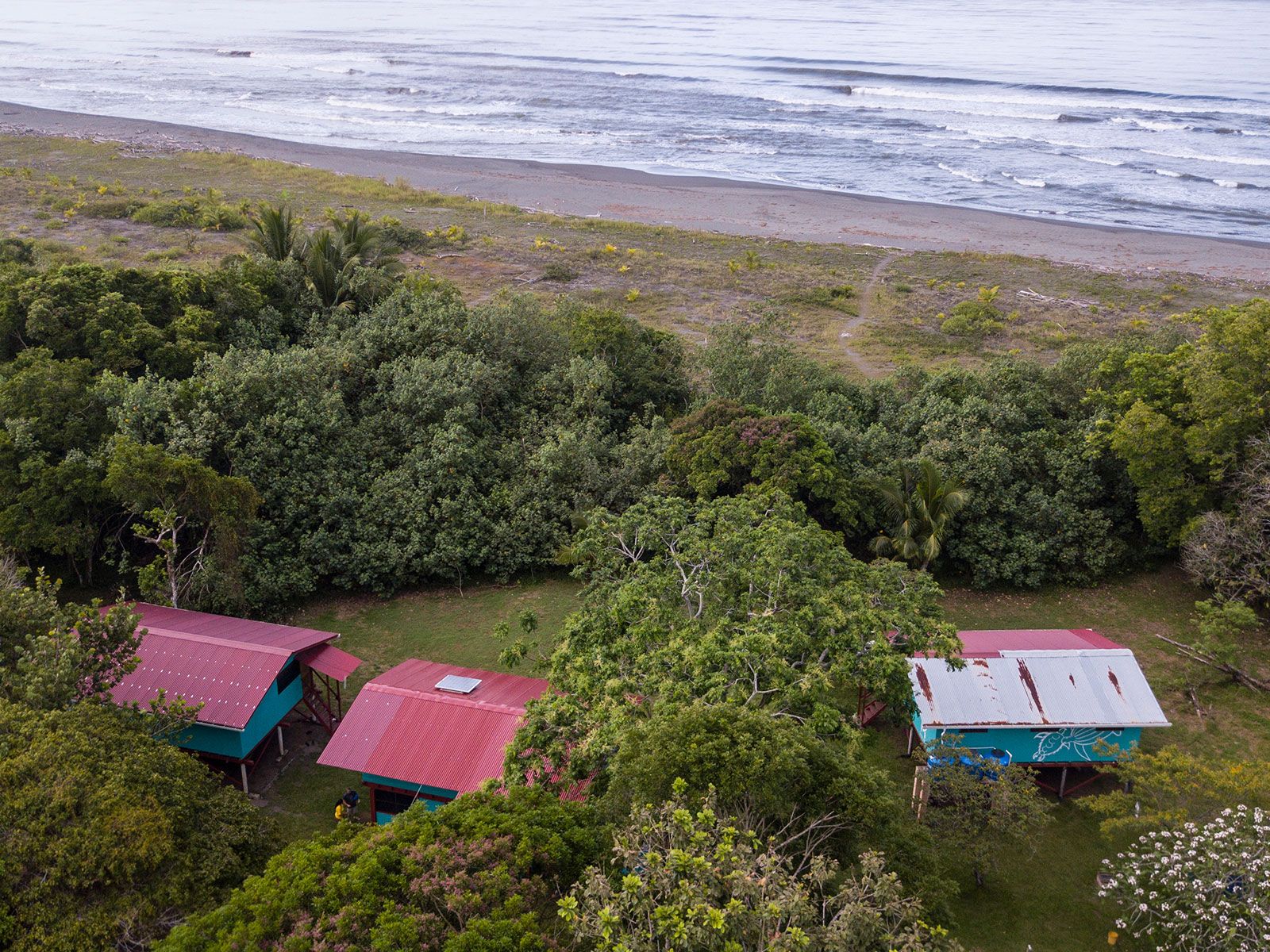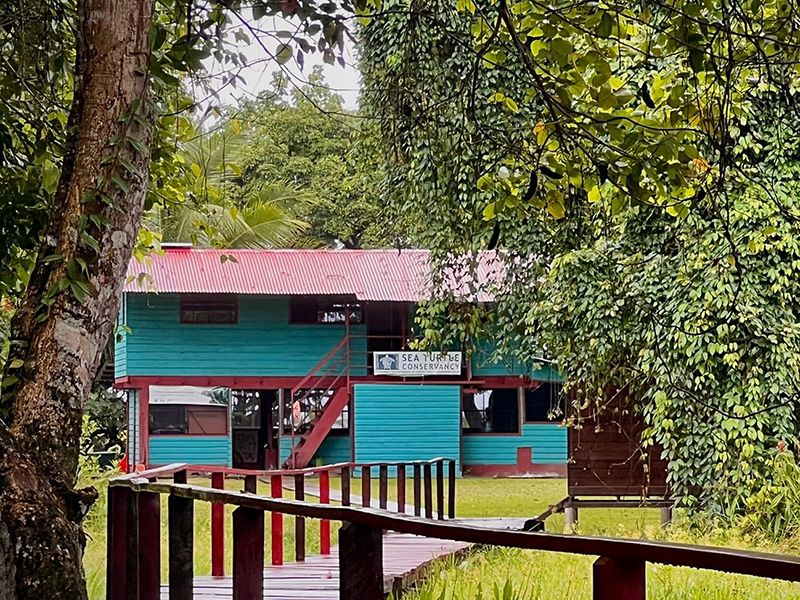Live the Experience
This fun and educational opportunity blends research with an exotic location to get you involved in protecting endangered sea turtles.
$700 for 5 Nights at STC’s Research Station (Lodging & Meals) and Research Training. Meet in Bocas del Toro, Panama.
The black sand beach of Soropta draws one of the largest nesting population of leatherback sea turtles in the Atlantic Ocean. Weighing up to 1,000 pounds, leatherback turtles are the largest sea turtles in the world.
STC studies have solved many of the mysteries of leatherback turtle reproductive ecology and behavior. Monitoring and tagging at Soropta Beach during the nesting months facilitates monitoring of the nesting population to evaluate the survival status of the species. Eco-Volunteer Participants will work with nesting turtles weighing up to 1,000 pounds and measuring 5 to 6 feet in length.


Nightly beach patrols

Morning nest surveys

Nest inventories
Have questions?
Eco-Volunteers must be 16 years or older. This experience is ideal for educators, couples, spring breakers, groups, or anyone who is interested in helping sea turtles and making a difference. Discounts are available for groups of six or more. If under 18, must be traveling with an adult.
A passport valid through the date of return is required. Non-U.S. citizens should contact the Panama Embassy for visa requirements. Upon registering, you will be sent a Field Station Manual providing packing tips, travel information, STC policies and site information.
Sea Turtle Conservancy’s research programs are scientific research projects, not guided tours. STC makes every effort to describe field conditions accurately, but fieldwork in remote locations is a delicate business and prone to last-minute change, flexibility is a must. STC’s programs are not package holidays! You will be assisting researchers with scientific field work at a remote field station, and when not working you will have unsupervised free time to relax and enjoy the nature surrounding you.
You are volunteering to join a field research team which has specific physical demands that you should be aware of:
All Eco-Volunteers must be in good physical health. It is important that all travelers are aware of the demanding physical conditions before signing up. We need you to accurately evaluate your ability to meet the conditions detailed below in order to safeguard your health and safety, and ensure that you can participate fully and effectively. If you feel you do not meet these considerations, please reconsider taking part in this program.
Phobias to snakes and insects may pose a problem, although encounters with snakes are unlikely. If you are allergic to insect bites, bees or wasps please come prepared with appropriate medication or epi-kit. To avoid dehydration and other heat related you must bring a water bottle in order to stay hydrated during field activities. Diabetics without previous experience of how physical exertion in a hot climate may affect their insulin levels are advised to speak with a doctor.
The minimum age for participants is 18 years old without a parent or legal guardian and 16 years old with a parent or legal guardian.
While there are no extreme physical conditioning or psychological demands, be sure you are able to walk at least 5 or 7 miles of beach each night for 4 or 5 hours. You must have good night vision, you will be walking without a flashlight at night during the patrols. You should be able to carry about a 5 lb pack (backpacks are used to carry the team’s field equipment) while walking on sand. Walking on uneven sand is difficult and not recommended for people with heart conditions, prosthetic limbs, or limited mobility. Phobias about being in the dark may pose a problem. Minor injuries or scrapes due to falls or tripping over obstacles on the beach can occur during nighttime work. Please also be aware that there is a good chance of getting sand thrown on you, with the possibility of getting it in your eyes, by a turtle’s flippers.
This is an exciting way to participate in sea turtle conservation while vacationing in an exotic, tropical location. What makes STC’s Eco-Volunteer program even better is that your money will be supporting sea turtle conservation at one of the most important nesting beaches in the Western Hemisphere. Plus, a portion of your fee is tax deductible!
Nesting season for leatherback turtles runs from March through July each year. Eco-Volunteer Adventures run from April into June, with each session running from Monday to Saturday. Please plan on adding at least 1 day of travel on either end of the session dates listed below for travel to/from Bocas del Toro, Panama.
2025 Leatherback Turtle Sessions
April 7 – 12, 2025
April 14 – 19, 2025
April 21 – 26, 2025
April 28 – May 3, 2025
May 5 – 10, 2025
May 12 – 17, 2025
May 19 – 24, 2025
June 2 – 7, 2025 (Full)
June 9 – 14, 2025
- STC boat transport to Soropta Beach from Bocas del Toro;
- All meals and accommodations while at STC’s Research Station in Soropta Beach;
- A tax-deductible donation in support of STC’s sea turtle research and conservation efforts in Soropta Beach.
- Your round trip International Air Transportation to and from Tocumen International Airport at Panama City, Panama;
- Hotel accommodations in Panama City, Panama or Bocas del Toro, Panama;
- Flights between Panama City and Bocas del Toro on Air Panama;
- All in-country transfers between airports and hotels.
- Items of a personal nature, phone calls and tips;
- Passport fees or fees not listed in the program;
- Meals while not at the STC station.
The costs of running a field station to enable scientists to conduct research are substantial. Some costs are covered by grants, and funds secured by the STC, and some by the fees paid by research eco-volunteer participants.
For the 2025 field season, the fee for a 5-night program is US$700.00 per person.
Group rate also available, please contact STC at stc@conserveturtles.org.
Cancellations & Refunds (for STC’s portion of the Program Cost):
- A refund of STC’s portion of the program cost, less a $100 administrative fee, will be made if cancellation is received in writing no less than 60 days prior to departure.
- Cancellations between 60 and 15 days prior to departure will have a 25% fee imposed unless a replacement is found.
- If a written cancellation is received less than 15 days prior to departure, a credit of STC’s portion of the program cost, less a $100 administrative fee, is given towards a session at a later date.
Eco-volunteers will stay at STC’s Soropta Biological Field Station, located in a tropical rainforest setting, and just steps from the black sand beach. There is only one type of accommodation available at Soropta Beach, very rustic.
Housing is dorm-style living, includes bunk beds with up to 4 people per room and a community bathroom. You will need to bring your own mosquito net for sleeping. (STC has some mosquito nets at the station, please check with STC for availability.)
There is no electricity, plumbing or potable water. There are rain barrels that can be used to fill toilets and for showers. If the rain barrels are empty, a well provides water for toilets and to wash. This is a rustic station. Meals, prepared Panamanian-style by a local cook, are served three times a day.
You are volunteering to join a field research team which has specific physical demands that you should be aware of.
We need you to accurately evaluate your ability to meet the conditions detailed below in order to safeguard your health and safety, and ensure that you can participate fully and effectively. If you feel you do not meet these considerations, please reconsider taking part in this program.
Sea Turtle Conservancy’s research programs are scientific research projects, not guided tours. STC makes every effort to describe field conditions accurately, but fieldwork in remote locations is a delicate business and prone to last-minute change, flexibility is a must. STC’s programs are not package holidays! You will be assisting researchers with scientific field work at a remote field station, and when not working you will have unsupervised free time to relax and enjoy the nature surrounding you.
Phobias to snakes and insects may pose a problem, although encounters with snakes are unlikely. If you are allergic to insect bites, bees or wasps please come prepared with appropriate medication or epi-kit. To avoid dehydration and other heat related you must bring a water bottle in order to stay hydrated during field activities. Diabetics without previous experience of how physical exertion in a hot climate may affect their insulin levels are advised to speak with a doctor.
The minimum age for participants is 18 years old without a parent or legal guardian and 16 years old with a parent or legal guardian.
While there are no extreme physical conditioning or psychological demands, be sure you are able to walk at least 5 or 7 miles of beach each night for 4 or 5 hours. You must have good night vision, you will be walking without a flashlight at night during the patrols. You should be able to carry about a 5 lb pack (backpacks are used to carry the team’s field equipment) while walking on sand. Walking on uneven sand is difficult and not recommended for people with heart conditions, prosthetic limbs, or limited mobility. Phobias about being in the dark may pose a problem. Minor injuries or scrapes due to falls or tripping over obstacles on the beach can occur during nighttime work. Please also be aware that there is a good chance of getting sand thrown on you, with the possibility of getting it in your eyes, by a turtle’s flippers.










